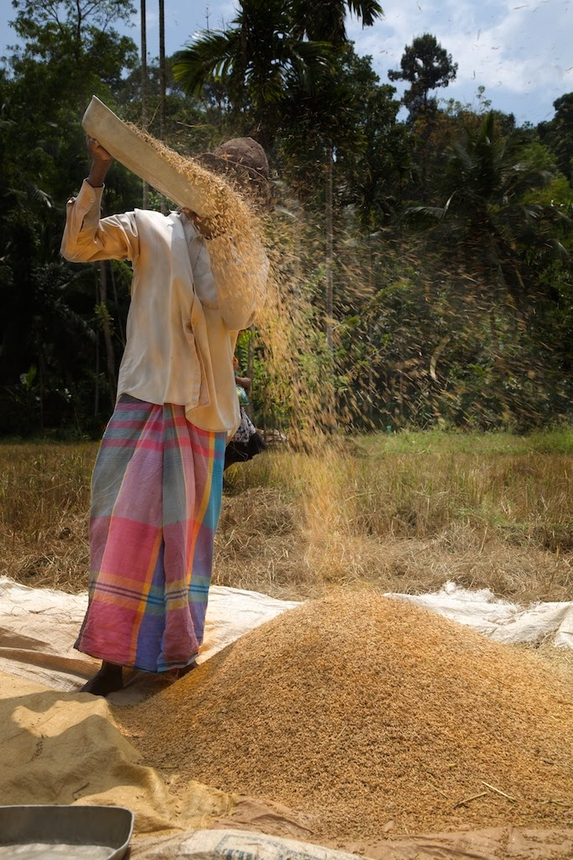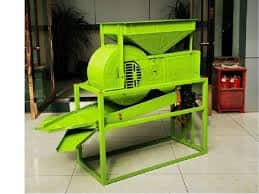Winnowing - Definition, Advantages and Disadvantages, Threshing FAQs
What is the method by which farmers separate lighter husk particles from heavier grains just by letting the wind do the work? Have you ever seen a farmer tossing grains into the air? If yes, then a question must arise in your mind why they are tossing grains into the air. So, the simple answer is that they are separating lighter husk from grain. We use various methods to separate things daily, like stones from rice and pulses, cream from milk, and tea particles from tea. The separation process is winnowing. Winnowing is the process of separating lighter particles from heavier particles with the help of wind. It is an easy and traditional method for the separation of materials based on weight.
This Story also Contains
- Winnowing
- Winnowing in Agriculture
- Principle of Winnowing
- Winnowing Machine
- Advantages of Winnowing
- Disadvantages of winnowing
- Winnowing and Threshing
- Some Solved Examples

Winnowing
Winnowing is defined as the method through which lighter particles get separated through heavier particles with the help of wind. This type of process is used for that mixture in which both the particles are of solid nature but one particle is very light as compared to the particle so it can easily get separated with the help of wind. The word winnow is generally derived from the English word ‘windwian’ which represents the separation of a mixture with the help of air. An example of winnowing is the separation of grains from husk. The method of separating grains from chaff is called threshing.
Separating the grain from the chaff is basically known by the process called threshing. Threshing can be defined as a process of separating grain from chaff, during this process mixture which contains wheat and husk particles is brought down from some height with this drop-down the lighter husk particles will blow away with the air which collected in the shape of the heap at some distance. Husk also takes the shape of a heap at some other distance. Dirt particles can be easily removed from grains with the help of winnowing process and corns are also separated from straw with the help of this process.
Winnowing in Agriculture

With the help of this picture, we can conclude how winnowing is useful to farmers as by this process we can easily separate out the husk particles from grain. Being lighter in weight it will blow out with air as shown in the image.
|
Related Topics Link, |
Principle of Winnowing
Winnowing is generally based on the principle that the mixture, which contains two components, of which one is lighter in comparison to the other, so that only lighter particles will blow with the air. This mixture is poured from a height, then the lighter one will separate from the heavier one with the blow of wind.
Winnowing Machine
Winnowing doesn't need any type of heavy machines. But some machines are designed for the process called winnowing. The first machine, which was designed for winnowing purposes, is known by the name wind winnowing machines. It was designed by the scientist named Andrew Rodger in the year of 1737. He is basically from Scotland and his profession was farming, he developed this machine for separating corn and to this machine, he gave the name fanner. After his discovery, so many other types of machines for winnowing will come in the market but in this era single machines work two processes called winnowing and threshing, which make their work easy and also time economical,l as they can complete two tasks in the same time which saves their both time and energy.
Here are some images of winnowing machine
.jpg)

Advantages of Winnowing
This is also said to be the main advantage of winnowing, that it does not need any type of machine; it basically depends upon the tendency of human beings. It is very cheap to perform and it is not much time time-consuming. We know that how to separate stones from rice the method will be hand picking if there are stones in the rice or grains we can easily separate them out with hand picking method but this method is not applicable for removing husk particles from grain as these are very light in weight so it is not possible to pick them all by hand picking method, therefore we apply winnowing method here.
Disadvantages of winnowing
Like advantages, there is also a number of disadvantages of winnowing,g which can be explained as:
1. Winnowing process is suitable only for those mixtures out of which one is lighter as compared to the other so it is not applicable for those mixtures which have the same size or we can say it is not applicable for heavy particles mixture.
2. Winnowing is the process in which lighter particles will blow out with the help of air so it is not possible to blow heavier particles this will give a limited scope to this process. Also, when the day is non-windy, then winnowing is also difficult.
Winnowing and Threshing
The winnowing process is done after threshing. We have to consider the main differences between these two processes, called winnowing and threshing.
1. Winnowing is the process of separating husk from grains, while threshing is the process of separating the grain from the chaff.
2. The winnowing process is used by farmers in such a way that grains and husks are allowed to fall from a height, and the husk will blow out with the help of air during this process, and in the threshing crop is struck on a hard surface.
3. Winnowing is done after threshing, while threshing is done before winnowing. These two processes are interrelated.
Also check-
Some Solved Examples
Question 1: During winnowing, a farmer tosses a mixture of wheat grains and husk into the air. The wheat grains fall almost vertically downwards, while the husk is carried away by the wind. Which of the following physical principles best explains this separation?
A) Archimedes’ Principle of Buoyancy
B) Newton’s Second Law of Motion
C) Bernoulli’s Principle
D) Difference in terminal velocities due to density and mass
Solution:
-
In winnowing, both husk and grains experience gravitational pull downwards.
-
Air provides an upward drag force, which depends on shape, surface area, and mass per unit volume (density) of the particle.
-
Husk is lighter and has a larger surface area compared to its mass → it experiences more air resistance relative to its weight, leading to a lower terminal velocity. Hence, the wind easily blows it away.
-
Wheat grains are denser and heavier → their terminal velocity is much higher, so they fall almost straight down.
Thus, the separation is based on the difference in densities/masses and terminal velocities, not buoyancy or Bernoulli’s effect.
Hence, the correct answer is (d)
Question 2: Winnowing is used to separate husk from grains because:
A) They differ in colour
B) They differ in shape only
C) They differ in mass and density
D) They differ in boiling point
Solution:
Husk is lighter with lower density → blown away by air. Grains are denser and heavier → fall vertically down.
Hence, the correct answer is (c)
Question 3: Which separation method is most similar in principle to winnowing?
A) Sedimentation
B) Centrifugation
C) Magnetic separation
D) Evaporation
Solution: Both work on the principle of separation based on differences in effective mass/density under a force (gravity/centrifugal).
Hence, the correct answer is (B) Centrifugation
Frequently Asked Questions (FAQs)
Winnowing refers to a process used to separate mixtures based on differences in size or density, similar to its traditional agricultural meaning. It involves separating particles from a mixture, allowing for the removal of unwanted materials and the isolation of the desired components.
While winnowing specifically aims to separate materials based on differences in size or density, other techniques like filtration or centrifugation may involve additional principles such as permeability or centrifugal force
Examples of winnowing in chemistry include the separation of larger crystalline salts from a reaction mixture or the removal of impurities from powdered substances by blowing air through the mixture. These processes allow chemists to purify substances and obtain more accurate results in experiments and reactions.
Winnowing can be applied in various industrial processes, particularly in the manufacturing of chemicals, pharmaceuticals, and food products. For instance, it can be used to separate desired particulates from byproducts, enhancing the quality and purity of the final product.
Common equipment used in winnowing includes air classifiers, which utilize airflow to separate particles based on size or density. Other equipment might include sieves and screens, which can physically separate larger particles from smaller ones, further enhancing the efficiency of the winnowing process.